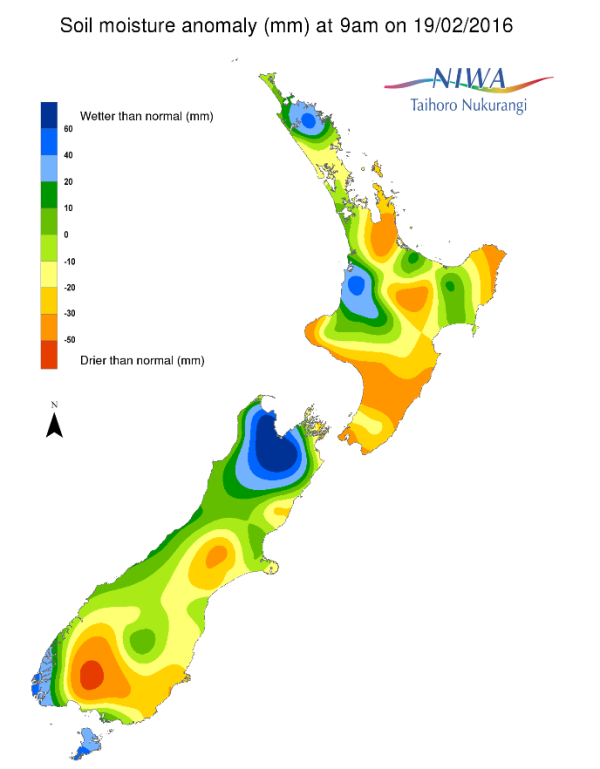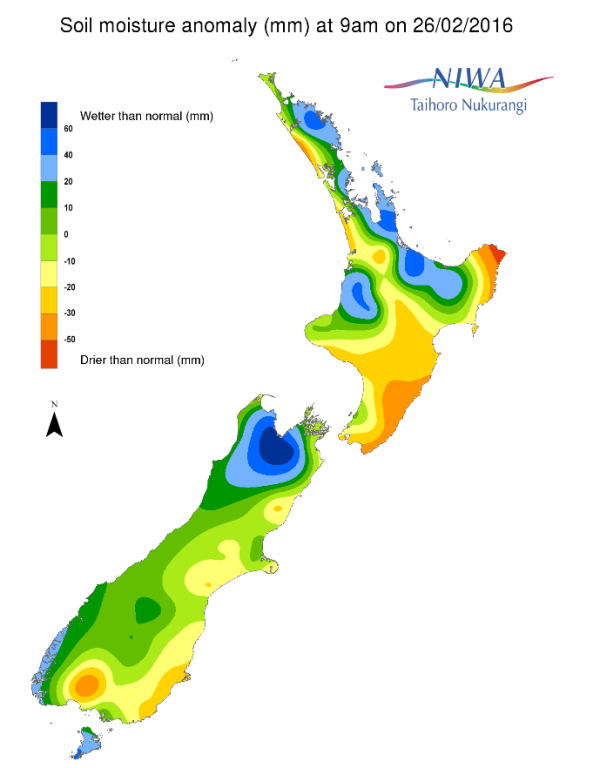A weekly update describing soil moisture across the country to help assess whether severely to extremely dry conditions are occurring or imminent. Regions experiencing these soil moisture deficits are deemed “hotspots”. Persistent hotspot regions have the potential to develop into drought.
On the North Island, soil moisture levels have generally remained the same or increased when compared to this time last week. While organised rainfall was sparse over the course of the past week, rain on the 17th and 18th of February led to widespread soil moisture increases from Northland to the Bay of Plenty, including Auckland and Waikato. Notable increases were also found in northern Taranaki and far northern Manawatu-Whanganui. The exception was across extreme northeastern Gisborne, where soil moisture decreased over the last week. Soil moisture remains near or below normal for much of Hawke’s Bay, southern and eastern Manawatu-Whanganui, and across Wellington-Wairarapa.
Across the South Island, moisture levels have largely increased over the last week. The most dramatic increases were found across the far north; while rain was not widespread across this region over the last 7 days, rain during the latter stages of the week of the 12th contributed significantly. Other areas of substantial soil moisture increase include the central and southern West Coast, southwestern Canterbury, and northwestern Otago. Soil moisture levels remain below normal for a small area in southern Southland, coastal Otago, and a few pockets in central and northern coastal Canterbury.
Outlook
Following a dry end to the week for most on the North Island, tropical, northerly flows will fuel downpours across the central and north into early next week. On Saturday, an area of locally heavy rain will push into Taranaki, western Waikato and parts of the Central Plateau. Falls in the order of 10-25 mm are expected with local amounts in excess of 25 mm. Meanwhile, lighter showers will move across Auckland and Northland with rainfall generally less than 10 mm. Showers will stretch to include the Bay of Plenty on Saturday night, then affect many of the same regions on Sunday, when there may also be a few thunderstorms. Isolated heavy rainfall in excess of 25 mm is again possible. By Sunday night and into Monday, some heavier showers and thunderstorms will spread to coastal Hawke’s Bay and Gisborne. Elsewhere across the central and northern North Island more downpours, which can be linked to the remnants of Cyclone Winston, will continue on Monday. Isolated flooding in low-lying and poor drainage areas is possible from later Saturday through Monday. A frontal boundary over the North Island on Tuesday will keep the shower risk alive from Hawke’s Bay to Northland. While a few showers may persist over the far northern North Island on Wednesday, building high pressure will help to dry things out toward the end of the week. Seven-day rain totals may exceed 75 mm in some places, with the heaviest falls expected from northern Taranaki through Northland. Many locales in the aforementioned corridor will see at least 25 mm over the next week. Meanwhile, only scattered rains are expected for east coastal Manawatu-Whanganui and Wellington-Wairarapa with weekly totals mainly less than 10 mm.
Numerous rounds of rain affected Fiordland and the West Coast over the course of the last week, a trend that will continue into this weekend. Total weekend rainfall for Fiordland will be 25 to 50 mm, with amounts less than 25 mm up to the southern West Coast. A southerly change later Sunday and into Monday will cause rain across central and eastern Southland, much of Otago, and into Canterbury and the far north by late Monday. Falls in the far south will be 10 to 25 mm but reduce considerably as one moves to the north, with only 5 to maybe 10 mm from lower Canterbury on north. While a few showers may persist in the far north on Tuesday, building high pressure will allow most places on the South Island a dry day. Wednesday also looks largely dry before a system may spread rain to the far south in the late week.
Soil Moisture
For the North Island, hotspot areas have been eliminated in much of Taranaki and the Coromandel Peninsula. Hotspot areas remain present in parts of southern Hawke’s Bay, eastern Wellington-Wairarapa, and east coastal Gisborne. A small hotspot remains in central Waikato. A new but very narrow hotspot area has developed in far western Waikato. Another very narrow hotspot exists in southwestern Northland. Locally heavy rainfall across the North Island over the next week may prevent hotspot expansion or development, especially across the central and north. A hotspot area in extreme coastal Gisborne may be reduced. Little in the way of organised rainfall through the next week will favour hotspot expansion across the southeastern part of the North Island.
On the South Island, hotspot areas have been eliminated in southwestern Otago and reduced across Southland. Other small hotspot areas remain present in coastal Otago and central and northern Canterbury. Hotspot areas across the eastern South Island may remain the same or expand over the next week. However, periods of rain across the far south of next week may prevent hotspot expansion there.
NB: due to the timing and reporting of daily 24 hour rainfall amounts (9 am each day) and time required to compute soil moisture deficit values, the rain that occurred on Friday 26 February will not be fully reflected in the soil moisture anomaly maps until Saturday 27 February.
Background
Hotspot Watch a weekly advisory service for New Zealand media. It provides soil moisture and precipitation measurements around the country to help assess whether extremely dry conditions are imminent.
Soil moisture deficit
Soil moisture deficit is the amount of water needed to bring the soil moisture content back to field capacity, which is the maximum amount of water the soil can hold.
Soil moisture anomaly
This is the difference between the historical normal soil moisture deficit (or surplus) for a given time of year and actual soil moisture deficits.
Definitions
“Extremely” and “severely” dry soils are based on a combination of the current soil moisture status and the difference from normal soil moisture (see soil moisture maps at https://www.niwa.co.nz/climate/nz-drought-monitor/droughtindicatormaps).
Soil moisture anomaly maps
Pictured below are soil Moisture Anomaly Maps, relative to this time of year. The maps show soil moisture anomaly for the past two weeks.


